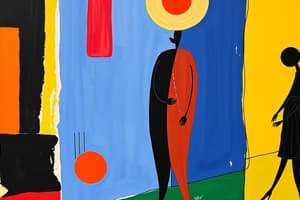Podcast
Questions and Answers
What does the term Neoclassicism refer to?
What does the term Neoclassicism refer to?
- A new movement in contemporary literature
- A revival and restoration of Classicism (correct)
- A rejection of classical elements
- A combination of ancient and modern art forms
What does the word 'neo' mean?
What does the word 'neo' mean?
young or new
Who were the leading writers of the Neoclassical period?
Who were the leading writers of the Neoclassical period?
Pope and Dryden
What period is also referred to as the Augustan Age?
What period is also referred to as the Augustan Age?
The Age of Johnson lasted up to _____
The Age of Johnson lasted up to _____
Neoclassical poets emphasized imagination over reason.
Neoclassical poets emphasized imagination over reason.
Match the following terms with their descriptions:
Match the following terms with their descriptions:
Which of the following was a hallmark of Neoclassical poetry?
Which of the following was a hallmark of Neoclassical poetry?
List two characteristics of Neoclassical poetry.
List two characteristics of Neoclassical poetry.
Flashcards are hidden until you start studying
Study Notes
Neoclassicism Overview
- Neoclassicism combines "neo," meaning new or young, with "classic," referring to the style of ancient Greek and Roman authors.
- Represents a rebirth and restoration of Classicism, emphasizing classical values in literature.
Historical Context
- The movement dominated English literature between 1680 and 1750, during the Age of Pope and Dryden, also known as the Augustan Age.
- Influenced by the literary traditions of the Roman Emperor Augustus, emulating writers like Horace, Virgil, and Ovid.
Key Periods in Neoclassicism
- Restoration Period (1660-1700): Marked by the restoration of King Charles II; noted poets include John Milton (e.g., "Paradise Lost"), John Dryden, and Samuel Butler.
- Augustan Age (1700-1745): Also called the Age of Pope, characterized by significant contributions from poets such as Alexander Pope, John Gay, and Jonathan Swift.
- Age of Johnson (up to 1798): Extended the characteristics of neoclassicism until the late 18th century.
Notable Writers and Their Works
- Augustan Poetry:
- Prominent figures: Alexander Pope, John Gay, Jonathan Swift.
- Augustan Prose:
- Key authors: Richard Steele, Joseph Addison, Alexander Pope, Eliza Haywood, Lady Mary Wortley Montagu.
- Augustan Novels:
- Significant works include Samuel Richardson's "Pamela," Daniel Defoe's "Robinson Crusoe," and Jonathan Swift's "Gulliver's Travels."
- Augustan Drama:
- Notable playwrights include Henry Fielding and John Gay, who wrote "The Beggar's Opera."
Characteristics of Neoclassical Poetry
- Rationalism: Emphasis on reason and intellect as critical elements of poetry.
- Scholarly Allusions: Poets drew from religious, biblical, and classical literature due to their education.
- Didactic Purpose: Aimed at instructing readers and imparting moral lessons.
- Realism: Presented a true picture of society, focusing on actual experiences.
- Adherence to Classical Rules: Prioritized classical structure and forms in their poetry.
- Heroic Couplet: Utilized a specific poetic form, with Dryden and Pope considered masters who refined it.
- Objectivity: Maintained emotional restraint, focusing on societal hardships rather than personal feelings.
- Concrete Diction: Used precise and rigorous language in their poetic expression.
Studying That Suits You
Use AI to generate personalized quizzes and flashcards to suit your learning preferences.




